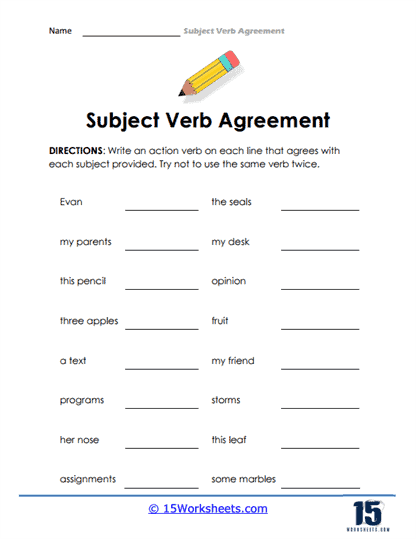

This collection of Subject-verb agreement worksheets are designed to help students learn and practice the rules of subject-verb agreement in English grammar. These worksheets provide a variety of exercises that require students to identify the subject and verb in a sentence, and ensure that they agree in terms of number (singular or plural).
These worksheets include fill-in-the-blank exercises, rewriting activities, and short writing prompts. By accomplishing these worksheets, students will:
These subject-verb agreement worksheets are an important tool for helping students improve their grammar skills and develop accuracy in their writing. By completing these exercises, students can gain a better understanding of the rules of subject-verb agreement and practice applying them correctly in their writing.
Often times a lengthy, complex subject is one thing that stumps writers. In the process, the author loses track of which noun serves as the subject phrase’s head and instead makes the verb agree with the closest noun. The shift from strict grammatical agreement to “notional agreement,” where the verb agrees with the concept or idea the subject is trying to express, whether it is singular or plural, is another pitfall for authors.
Conflict in any form is disliked, even inside phrases! Every sentence must contain a subject and a predicate, as we all know, but they also need to be in agreement with one another. This is referred to as subject-verb agreement in the grammar field.
Subjects and verbs most frequently differ in number and tense, respectively. In the event that the subject is plural, the verb must likewise be plural. Similarly, if the subject is multiple, the verb must be plural as well. Although it appears obvious, things can get challenging when discussing time, money, indefinite pronouns, collective nouns, and interrupting expressions.
If you were to say, “They are fun,” using the plural subject they, you would say, “They are.” Additionally, if you were to say “She is enjoyable” using the singular she, you would also use the singular is. The subjects and verbs in “She are fun” and “they is fun” don’t agree. Hence those sentences make no sense.
When a verb agrees with the portion of the subject closest to the verb, when a compound subject has both a singular, and a plural noun connected by “nor” or “or” the verb should agree with both parts of the subject. This is also known as the proximity rule. For instance, the committee members or the student both write every day.
It might be challenging to determine whether a verb should be single or plural when it is so far removed from the sentence’s subject. Appositive phrases, prepositional phrases, and direct objects are frequently misunderstood as indicating the number of the verb. It’s not like that at all! Only the subject determines whether a verb is singular or plural.
For instance: One of the many popular actors in Hollywood, Dwayne Johnson, follows a rigorous exercise routine. Although the appositive word in this sentence includes the plural noun actors, the subject in this sentence, Dwayne Johnson, is still single. Hence the verb “has” must still be singular.
Singular and Plural
Use the verb form of the subject that is closest to the verb if one subject is single and the other is plural, and the words are joined by the letters “or,” “nor,” “not only/but also,” and “neither/nor.” The lion or the bears have gotten out of the zoo. Whenever there are multiple words connected with the help of a conjunction, the verb is singular if the subjects are both singular and are related by the terms. When the conjunctions “or,” “nor,” “neither/nor,” “either/or,” or “not only/but also” link two plural subjects, the verb is plural.
Finding the appropriate subject and verb will enable you to fix subject-verb agreement mistakes. A sentence containing the prefix of comes before a topic. The key to comprehending subjects is to follow this guideline. The culprit in many, if not most, subject-verb blunders is the word of. Hasty speakers or writers may fail to catch the following all-too-common error: Yellow roses in a bouquet provide color and scent to the space.